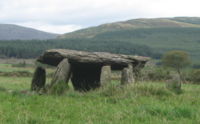
Glantane east
Encyclopedia


Millstreet
Millstreet is a town in north County Cork, Ireland with a population of approximately 1,500. It is located at the foot of Clara Mountain. The town's Catholic church is dedicated to St. Patrick. Since October 1985, the town has been twinned with Pommerit-le-Vicomte in Brittany, France...
, County Cork
County Cork
County Cork is a county in Ireland. It is located in the South-West Region and is also part of the province of Munster. It is named after the city of Cork . Cork County Council is the local authority for the county...
, Ireland. It is set in the Keel River valley on the north-west upper slopes of Musherabeg mountain, in the townland
Townland
A townland or bally is a small geographical division of land used in Ireland. The townland system is of Gaelic origin—most townlands are believed to pre-date the Norman invasion and most have names derived from the Irish language...
of Glantane. The complex includes a wedge tomb
Wedge-shaped gallery grave
A wedge-shaped gallery grave or wedge tomb is a type of Irish chamber tomb. They are so named because the burial chamber itself narrows at one end , producing a wedge shape in elevation. An antechamber is separated from the burial area by a simple jamb or sill, and the doorway generally faces west...
, two stone circle
Stone circle
A stone circle is a monument of standing stones arranged in a circle. Such monuments have been constructed across the world throughout history for many different reasons....
s and a pair of stone alignments.
The wedge tomb is known locally as "The Flags" and is 90 centimetres (35.4 in) in height, with a capstone 2.4 metres (7.9 ft) square resting on two sidestones and a backstone. Some of the double-walling remains in place while a 40 centimetres (15.7 in) stone is positioned between the two sidestones.
A stone circle lies in the field next to the wedge tomb. It is nearly 5 metres (16.4 ft) in diameter with five standing and six fallen stones, some of which now lie in the surrounding ditch which is at least partly stone-faced. In the middle of the circle is a large hole, where it is assumed a boulder or boulder-burial once stood. The remaining stones vary in height from 0.5 to 1 m (1.6 to 3.3 ft) and are surrounded by a 2.5 metres (8.2 ft) wide fosse and low bank. Two tall pillar-like stones are situated along the outer face of the fosse and 8m to the south-east of the circle. One is fallen.

